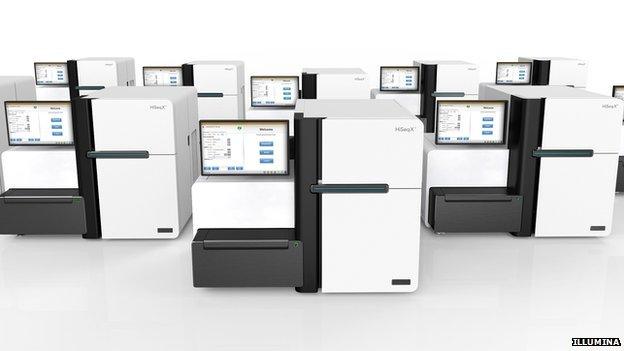Science enters $1,000 genome era
- Published

The HiSeq X Ten is capable of sequencing five human genomes a day, Illumina claims
The ability to sequence a human genome for just $1,000 has arrived, a US genetics company has announced.
San Diego-based Illumina says it is to release a new sequencing machine that can deliver five genomes in a day.
The race to unlock a human's genetic blueprint for $1,000 has been underway for more than a decade.
The Archon X Prize had offered $10m to the first team that hit this target or came closest, until the contest was cancelled in August 2013.
The term was thought up as a symbolic landmark that would, in theory, light the fires of a long-anticipated revolution in personalised medicine.
Understanding how genes influence disease could lead to better treatments for patients.
The HiSeq X Ten high throughput genetic sequencing machine was announced at the annual JP Morgan Healthcare Conference in San Francisco this week.
In his presentation at the meeting, Illumina's chief executive Jay Flatley said the HiSeq X Ten would improve on the scanning speed of its predecessor by a factor of six. This would offer the ability to sequence five whole human genomes in a single day, Bio-IT World reported, external.
He said the $1m sequencers (sold in a minimum of 10 units) would be able to deliver a genome for just under $1,000 (£610; 735 euros), consistent with calculations the National Human Genome Research Institute uses to estimate sequencing costs.
In his presentation, Mr Flatley said the world was "entering the supersonic age of genomics".
"For the first time, it looks like it will be possible to deliver the $1,000 genome, which is tremendously exciting," said Eric Lander, a founding director of the Broad Institute in Massachusetts - which has bought 14 units.
"The HiSeq X Ten should give us the ability to analyse complete genomic information from huge sample populations. Over the next few years, we have an opportunity to learn as much about the genetics of human disease as we have learned in the history of medicine."
On his blog, external, Mick Watson, a computational biologist at the University of Edinburgh, checked the maths behind Illumina's claims for the HiSeq X Ten.
"I think they might be right in claiming the $1000 genome - if you do 18,000 human genomes per year for four years on each X Ten system. That's a lot of human genomes though," he wrote.
The term "$1,000 genome" was coined in 2001 at a closed scientific meeting to discuss the future of biomedical research. A year later, it became the subject of a symposium in Boston hosted by entrepreneur and genome pioneer Dr Craig Venter.
In the last few years, the decline in the cost of genome sequencing had outpaced the famous Moore's Law, which describes how computer processors double in complexity every two years. Nevertheless, the target proved difficult to reach, even with large sums of money on offer.
Dr Venter's foundation offered $500,000 to the first team able to realise $1,000 genome sequencing.
This sum was subsequently rolled into the Archon X Prize competition which was to have awarded $10m to successful scientists. However, this contest was cancelled in August 2013 because the effort had, in the words of X Prize co-founder Peter Diamandis, been "outpaced by innovation".
"What we realised is that genome sequencing technology is plummeting in cost and increasing in speed independent of our competition," he explained in a column, external for the Huffington Post.
Paul.Rincon-INTERNET@bbc.co.uk and follow me on Twitter, external
- Published24 July 2012